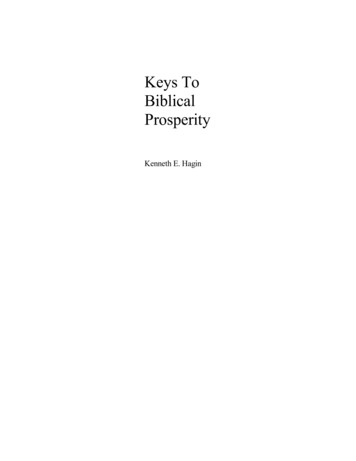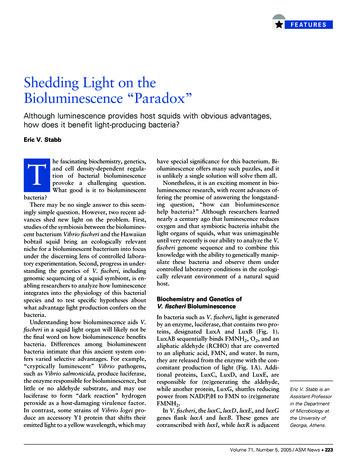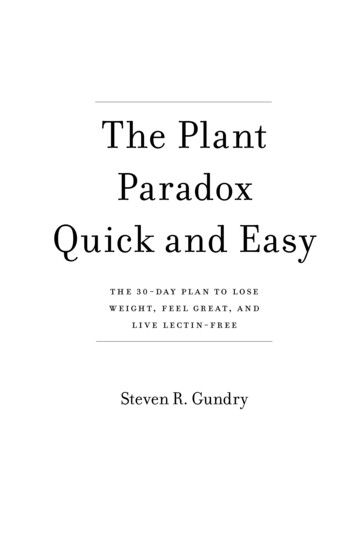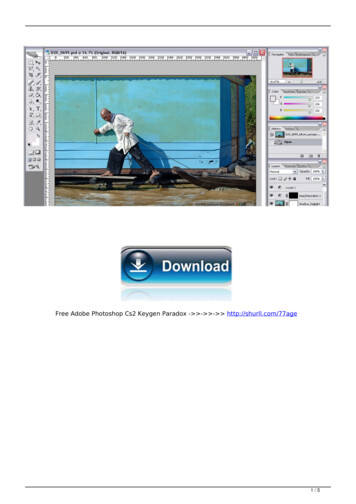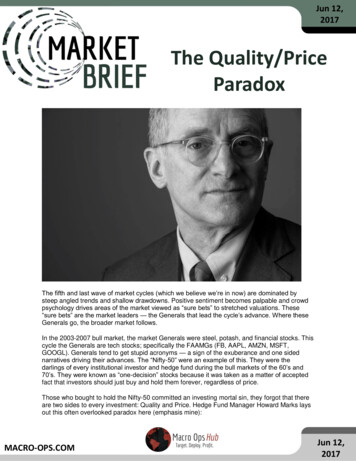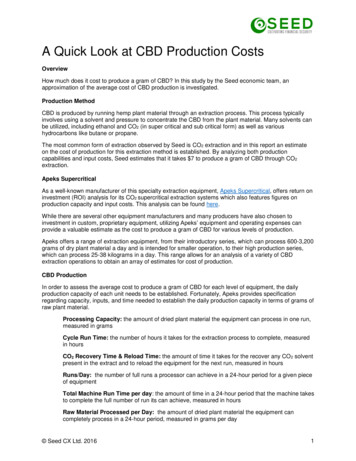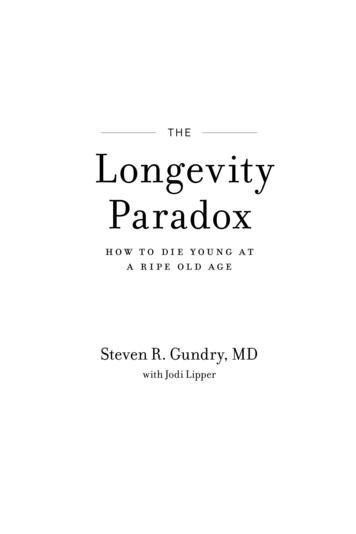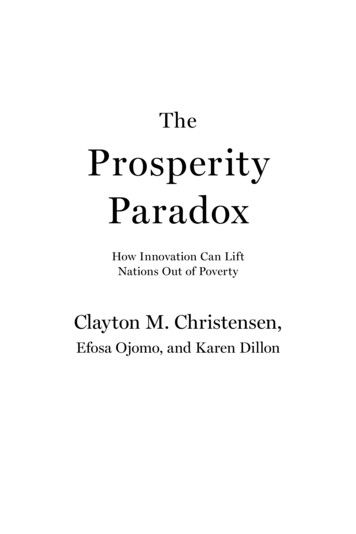
Transcription
TheProsperityParadoxHow Innovation Can LiftNations Out of PovertyClayton M. Christensen,Efosa Ojomo, and Karen Dillon
the prosperity paradox.Copyright 2019 by Clayton M. Christensen, Efosa Ojomo,and Karen Dillon. All rights reserved. Printed in the United States of America. Nopart of this book may be used or reproduced in any manner whatsoever withoutwritten permission except in the case of brief quotations embodied in critical articlesand reviews. For information, address HarperCollins Publishers, 195 Broadway, NewYork, NY 10007.HarperCollins books may be purchased for educational, business, or salespromotional use. For information, please email the Special Markets Department atSPsales@harpercollins.com.first editionLibrary of Congress Cataloging- in- Publication DataNames: Christensen, Clayton M., author. Ojomo, Efosa, author. Dillon,Karen (Editor), author.Title: The prosperity paradox / Clayton M. Christensen, Efosa Ojomo, andKaren Dillon.Description: First edition. New York, NY : HarperBusiness, [2019] Includes bibliographical references and index.Identifiers: LCCN 2018028690 ISBN 9780062851826 (hardcover)Subjects: LCSH: Economic development. Wealth. Poverty.Classification: LCC HD82 .C5224 2019 DDC 339.2—dc23 LC record available athttps://lccn.loc.gov/201802869019 20 21 22 23 lsc 10 9 8 7 6 5 4 3 2 1
PrefaceNOTES1. OECD stands for Organization for Economic Cooperation and Development, and is a group of thirty-five member nations, including the United States,France, Germany, and several of the world’s most developed countries. “Aboutthe OECD: Members and Partners,” OECD, accessed January 16, 2018, .194378.2. Fareed Zakaria, “Give South Korea a Gold Medal,” Washington Post, February 8, 2018, 890-372e2047c935 story.html?utm term .ac6f9aa492cf.3. For example, in today’s dollars, America’s annual income per capita in thatera was approximately 3,363, Angola’s today is 3,695, Mongolia’s is 3,694,and Sri Lanka’s is 3,844. Unless otherwise stated, GDP per capita numbers arebased on 2016 figures and are retrieved from the World Bank. “GDP per capita(current US ),” Data, The World Bank, accessed February 5, 2018, D?locations AO-MN-LK.4. Michael Haines, “Fertility and Mortality in the United States,” Economic History Association, accessed January 16, 2018, y-in-the-united-states/.“Mortality rate, infants (per 1,000 live births),” The World Bank, accessedFebruary 21, 2018, N.5. Much has been written about the question of how the West became prosperous and, more generally, how poor countries can become prosperous. We recognize that there is a large body of important work in this field. Several booksand papers provide very important insight to these questions. The fundamentalwork is Joseph Schumpeter’s The Theory of Economic Development: An Inquiryinto Profits, Capital, Credit, Interest, and the Business Cycle (1934, translated fromthe original 1911 German transcript). In this book, Schumpeter helps us seeclearly the role of innovation and the entrepreneur in economic development.As entrepreneurs innovate, or create new products or new methods of production, they disturb the “circular flow” in an economy, a process which describesa state of equilibrium in society. Although this perpetual “disturbance”—a process marked by new innovations—does come with some measure of instabilityand uncertainty, the end result is often a more prosperous society. For example,the car destabilized the horse and carriage and electric railcars, but has madeus more prosperous. For Schumpeter, entrepreneurs—the Henry Fords of theworld—are the stars in the economic development story. As you’ll read throughout this book, we certainly agree.In the last half century, must-reads for those interested in the ascendency of theWest include Douglass North and Robert Thomas’s The Rise of the Western World:1
A New Economic History (1973), Nathan Rosenberg’s and Luther E. Birdzell’s Howthe West Grew Rich: The Economic Transformation of the Industrial World (1986),and David Landes’s The Wealth and Poverty of Nations: Why Some Are So Rich andSome So Poor (1999). David Landes provides rich economic history and stressesseveral factors, including geography and culture, that helped Europe prosper.North and Thomas summarize their argument as follows, “Efficient economicorganization is the key to growth; the development of an economic organization inWestern Europe accounts for the rise of the West.” In essence, they helped bringto light the importance of institutions and property rights.In addition, several seminal papers have shed light on this topic. For instance, we have learned from Robert Lucas’s Making a Miracle (1993), RicardoHausmann and Dani Rodrik’s Economic Development as Self-Discovery (2002),and Richard Nelson and Edmund Phelps’s Investment in Humans, TechnologicalDiffusion, and Economic Growth. In their own way, each of these economistshave helped simplify, in varying degrees, the complexity inherent in the topicof economic growth and development. This has helped us better understandsome of the ingredients necessary for sustained economic growth. Robert Lucas helps us understand the importance of on-the-job “learning by doing” inincreasing the productivity of economies. Lucas additionally explains that themain features of the East Asian miracles have all “involved sustained movement of the workforce from less to more sophisticated products,” beyond increased efficiencies in the production of existing products. Hausmann andRodrik explain that, while it is important for entrepreneurs within a countryto learn what they’re good at making, the social returns often outweigh theprivate returns. This is because, on paper, firms that learn how to develop innovations that can solve a societal problem can be easily copied by “secondentrants,” which has the effect of strongly diluting a priori incentives to take onthe arduous work of developing the innovation in the first place. As such, thismakes investments in the kind of learning that leads to structural economicchange difficult. In these circumstances, development professionals and policymakers can play a significant role. Nelson and Phelps focus on human capitaland technology diffusion. In effect, they hypothesize that “in a technologicallyprogressive or dynamic economy, production management is a function requiring adaption to change and that the more educated a manager is, the quicker hewill be to introduce new techniques of production.”In this book we focus on the impact that market-creating innovations haveon creating and sustaining economic prosperity. In Chapter 2, we provide both adefinition and a categorization for the word innovation, and explain how different types of innovation impact economies.6. Press Release, “World Bank Forecasts Global Poverty to Fall Below 10%for First Time; Major Hurdles Remain in Goal to End Poverty by 2030,” TheWorld Bank, October 4, 2015, goal-to-end-poverty-by-2030.7.In some ways, China’s meteoric development over the past fifty years won’t2
come as a surprise to students of history. The wheelbarrow, soil science, cardboard, the magnetic compass, deep drilling for natural gas, knowledge of circulation of blood, paper and printing, gun powder, and hundreds of other inventionsare attributed to the Chinese. It was the Europeans who were playing catch up inthe Middle Ages. In the 1500s for instance, China’s economy accounted for 25%of global GDP. But by 1950, it was only 5%. Today, however, as China is making acomeback, its share of global GDP hovers around 19%.Still, China’s recent economic growth is spectacular, especially consideringthe hundreds of millions of people who have been lifted out of poverty. Theconventional story of China’s growth is that discontinuities in policy initiatedby Deng Xiaoping in the late 1970s unleashed the previously dormant economic giant. This is certainly true to a point. However, it is not possible to tellthe story of China’s rise without emphasizing the initiative of entrepreneursand other citizens. MIT’s Yasheng Huang explains that China’s economic policy in the 1980s actually favored entrepreneurship and market-driven solutionsas we saw a significant rise in Town and Village Enterprises in the country.He calls the 1980s “the Entrepreneurial Decade.” However, by the 1990s, thecountry’s economic policy shifted more toward a state-led, top-down approachwith the rise of many state-owned enterprises. While the economy still grew,Huang explains that this type of growth was not as robust and inclusive asChina’s growth in the 1980s.Even then, we still see China on the ascent. Just recently, the Washington Postpublished a piece titled “China increasingly challenges American dominance ofscience.” The authors note that an increasing number of scientists in some of themost prestigious institutions in the United States are leaving to set up labs inChina. Although the United States still spends roughly half a trillion dollars onscientific research annually, China is close behind and is on track to surpass theUS by the end of 2018. And for the first time, in 2016, annual scientific publications from China outnumbered those from the United States. China’s economyis a far cry from where it was in the 1960s and 1970s, and seems to be returningto its dominance in the yesteryears.Yasheng Huang, Capitalism with Chinese Characteristics: Entrepreneurship andthe State (New York: Cambridge University Press, 2008).Ben Guarino, Emily Rauhala, and William Wan, “China increasingly challenges American dominance of science,” Washington Post, June 3, 2018, tory.html?noredirect on&utm term .99a54422d595.Philip Auerswald, “China’s sudden fall and slow recovery,” New York Times, August 11, 2008, dauerswald.1.15175911.html.8. In 1990, there were approximately 282 million people living in poverty,representing about 55 percent of sub-Saharan Africa’s population. In 2013, thatnumber was 401 million, roughly 42 percent of the population. “Poverty headcount ratio at 1.90 a day (2011 PPP),” Data, The World Bank, accessed March 13,2018, F.3
9. Deirdre McCloskey’s Bourgeois series provides a detailed overview of economic history and an analysis of the many suggested causes of economic growth.In the second of the three, Bourgeois Dignity: Why Economics Can’t Explain theModern World, McCloskey details many of the widely held theories—institutions,transportation infrastructure, foreign trade, slavery, thrift, capital accumulation,the Protestant work ethic, expropriation, human capital (education), geographyor natural resources, science, and a few others—on what might have caused theeconomic transformation brought about by the Industrial Revolution and suggests that they all miss the mark. This particular 592-page volume explains why,as interesting and plausible as all these explanations seem, they are not responsible for bringing us toilets, air conditioners, automobiles, and mobile phones.Deirdre McCloskey, Bourgeois Dignity: Why Economics Can't Explain the ModernWorld (Chicago: University of Chicago Press, 2010), 34–35.10. This amount does not include private funds spent by some of the world’s heavily endowed foundations and organizations, such as the Bill and Melinda GatesFoundation, the Skoll Foundation, the Omidyar Network, and many others.“ODA 1960-16 Trends,” Official Development Assistance 2016, Compare YourCountry, accessed February 1, 2018, http://www2.compareyourcountry.org/oda?cr 20001&lg en&page 1#.11. Many of the countries in the above table have received official development assistance for poverty eradication programs from the World Bank andseveral other development institutions. Niger, for instance, has received 2.9billion worth of World Bank aid since 1964, but in 2015 its per capita incomewas less than half what it was in the 1960s. “Urban Water and Sanitation Project,” The World Bank, ter-sanitation-project?lang en.12. Jamie Skinner, “Why every drop counts: tackling rural Africa’s water crisis,”IIED briefing, accessed February 1, 2018, http://pubs.iied.org/pdfs/17055IIED.pdf.4
Chapter 1An Introduction to theProsperity ParadoxNOTES1.Now part of Bharti Airtel Limited.2. “Number of unique mobile subscribers in Africa surpasses half abillion, finds new GSM study,” GSMA, accessed February 1, 2018, half-a-billion-finds-new-gsma-study/.3. By “market,” we mean a system that enables the making, buying, andselling of a product or service.4. “Aid at a glance charts,” Development Finance Statistics, OECD, accessed April 23, 2018, 5. Clayton Christensen, The Innovator’s Dilemma: When New Technologies Cause Great Firms to Fail (New York: HarperCollins Publishers, 2000).This definition is consistent with Schumpeter’s writing in The Theoryof Economic Development defining innovation as taking an invention andplacing it firmly into a market, a process which leads to development orthe production of new combinations. In Chapter 2, Schumpeter writes, that“to produce means to combine materials and forces within our reach. Toproduce other things, or the same things by a d
A New Economic History (1973), Nathan Rosenberg’s and Luther E. Birdzell’s How the West Grew Rich: The Economic Transformation of the Industrial World (1986), and David Landes’s The Wealth and Poverty of Nations: Why Some Are So Rich and Some So Poor (1999).David Landes provides rich economic history and stresses

